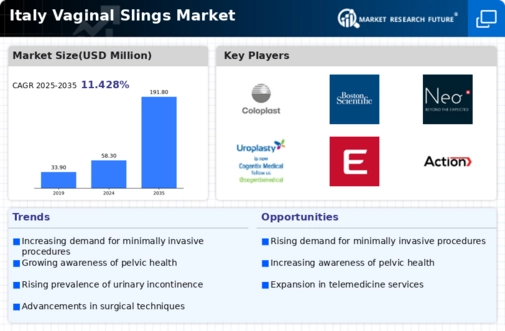Advancements in Surgical Techniques
Innovations in surgical techniques are significantly influencing the vaginal slings market. Minimally invasive procedures, such as laparoscopic and robotic-assisted surgeries, are gaining traction among healthcare professionals in Italy. These advancements not only reduce recovery times but also minimize complications associated with traditional surgical methods. As a result, more patients are likely to opt for surgical solutions to address pelvic floor disorders. The vaginal slings market is experiencing a shift towards these advanced techniques, which are perceived to enhance patient outcomes. Moreover, the increasing training and availability of skilled surgeons proficient in these methods could further drive market growth. The integration of technology in surgical practices is expected to lead to a more favorable perception of vaginal sling procedures among patients.
Increasing Incidence of Pelvic Floor Disorders
The rising incidence of pelvic floor disorders among women in Italy is a crucial driver for the vaginal slings market. Conditions such as stress urinary incontinence and pelvic organ prolapse are becoming more prevalent, particularly among the aging population. According to recent health statistics, approximately 30% of women over 50 experience some form of pelvic floor disorder. This growing demographic is likely to seek effective treatment options, thereby increasing demand for vaginal slings. The vaginal slings market is poised to benefit from this trend, as healthcare providers are increasingly recommending surgical interventions for these conditions. Furthermore, the awareness of available treatment options is expected to enhance patient engagement, leading to higher adoption rates of vaginal slings in clinical practice.
Growing Investment in Women's Health Initiatives
There is a notable increase in investment directed towards women's health initiatives in Italy, which is positively impacting the vaginal slings market. Government and private sectors are recognizing the importance of addressing women's health issues, leading to enhanced funding for research and development. This financial support is likely to facilitate the introduction of innovative products and improve existing treatment options. The vaginal slings market stands to gain from these initiatives, as they promote awareness and education regarding pelvic floor disorders. Furthermore, increased funding may lead to more comprehensive healthcare programs that include screening and treatment for conditions requiring vaginal slings, thereby expanding the market reach.
Rising Demand for Non-Invasive Treatment Options
The growing preference for non-invasive treatment options among patients is a significant driver for the vaginal slings market. Many women are increasingly seeking alternatives to traditional surgical procedures due to concerns about recovery times and potential complications. This trend is prompting healthcare providers to explore and recommend vaginal slings as a viable option for managing pelvic floor disorders. The vaginal slings market is likely to benefit from this shift, as more patients become aware of the effectiveness and safety of these devices. Additionally, the development of new materials and designs that enhance comfort and efficacy may further attract patients seeking non-invasive solutions. This evolving demand could lead to a broader acceptance of vaginal slings in clinical settings.
Enhanced Patient Education and Awareness Programs
Enhanced patient education and awareness programs are playing a pivotal role in shaping the vaginal slings market. Healthcare providers in Italy are increasingly focusing on informing women about pelvic floor disorders and the available treatment options, including vaginal slings. These initiatives aim to empower patients to make informed decisions regarding their health. As awareness grows, more women are likely to seek treatment for conditions that may have previously gone unaddressed. The vaginal slings market is expected to benefit from this trend, as increased knowledge can lead to higher consultation rates and subsequent adoption of vaginal sling procedures. Furthermore, educational campaigns may help to destigmatize discussions around women's health issues, fostering a more supportive environment for those affected.




















Leave a Comment